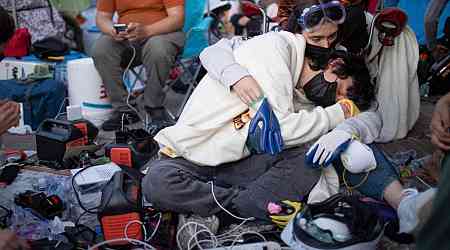It took a few years, but Utah finally solved the simple math problem that has dogged homeless services.
State lawmakers this session approved funding to build a 600- to 800-bed shelter in Salt Lake County, filling the gap in bed space that was left behind in 2019 when a centralized downtown shelter closed and pushed unsheltered Utahns into smaller resource centers dispersed across Salt Lake City and South Salt Lake.
When the new facility opens, it will be the largest shelter the state has seen in years, doubling, tripling or even quadrupling the size of the resource centers, which house 200 to 300 people, depending on the location.
The big question now about the bigger shelter is where it will be built.
“We’re looking at private and state-owned land,” said state homelessness coordinator Wayne Niederhauser, “but it’s not right for us to talk about that until … we have something for sure.”
When the facility opens, it could help pull Utah out of the annual race to ramp up services in the coldest months and ramp them down in the spring.
The beds created by this traditional shelter would be bolstered by a permanent “microshelter” site, which also received funding from the Legislature. That site, a response to calls for a legal homeless camp, is slated to open in Salt Lake City near 700 West under 500 South freeway ramps.
Niederhauser said the plan is for the microshelter site to feature 100 beds, double the size of a temporary site operating at 600 West and 300 South.
The idea is to create a low-barrier indoors option for those who have resisted seeking shelter at a traditional facility. The microshelters look like stripped-down tiny houses, featuring beds, tables, lockable doors, electricity and heating and cooling units.
Funding for the microshelter site and the traditional shelter will flow from a $25 million pot the Legislature appropriated in the final stretch of the session. Lawmakers kicked in another $21.8 million — $10 million of which is for ongoing funding — to help with operations across the system.
Lawmakers overhaul homeless services
The additional funding was part of a host of measures legislators embraced to change how Utah grapples with homelessness. Those included:
• HB298: Overhauls the makeup of the Utah Homelessness Council by dramatically reducing its membership and renaming it the Utah Homeless Services Board; creates new data reporting requirements; and gives police the ability to enforce municipal prohibitions against illegal camping when temperatures plunge and “Code Blue” alerts are called.
• HB299: Strengthens the ability to commit individuals to treatment against their will.
• HB421: Creates a court pilot program to provide supervised treatment and services to people in Salt Lake County who are experiencing mental illness; effectively prioritizes space in Midvale’s family shelter for those who are documented; allows the state hospital to contract with other providers that can offer a similar level of care; raises the threshold for calling a Code Blue alert to 18 degrees (it was previously 15); permits the homelessness board to divert shelter mitigation funding to the Utah Department of Public Safety from police agencies in cities that host shelters if those law enforcement agencies don’t enforce prohibitions on camping and panhandling.
• HB394: Changes how homeless services are funded across the state.
• HB548: Allows those who buy alcohol from the Department of Alcoholic Beverage Services to round up their purchases to donate to the Pamela Atkinson Homeless Account. This program could generate an estimated $4 million a year.
• SB139: Allows courts to order the administration of antipsychotic medication to ensure defendants can maintain their competency to stand trial.
Dale Keller, executive board chair for Solutions Utah, a group focused on homelessness policy, said HB298, sponsored by Provo Republican Rep. Tyler Clancy, represents a pivotal change in how the Beehive State tackles the growing crisis.
The bill changes the Utah Homelessness Council, Keller said, “from what was a very unworkable [group], just because of the pure numbers, down to a board that is nimble and could focus on moving forward with some of the issues.”
Private money could help fuel new shelter
On top of the structural changes to the system and the infusion of public money, the private sector also vowed to chip in cash. The Utah Impact Partnership, a coalition of influential Utahns who have taken aim at the state’s homelessness crisis, committed $15 million in philanthropic money.
Michael Parker, the group’s executive director, said the money will be used for “strategic projects” and “gap financing” but added that he doesn’t have an answer for how specifically it will be spent. Options, he said, could include contributing to detox programs or new shelter space.
Parker said his group will be pushing for additional beds from the microshelter community and the new traditional shelter to open quickly. He wants to see them start to become available by April of next year.
“The community needs to have some high urgency,” he said, “about both of those efforts getting on line as fast as possible, period.”
Niederhauser said turning the parcel under the freeway overpasses at 700 West into a permanent microshelter camp is going to take time, but he is confident that project can be operational by late summer or early fall. The larger traditional shelter, he said, could be available for the winter of 2025-26.
The homelessness coordinator said he wants to keep about 400 temporary beds available until that new facility opens, so many individuals who are occupying the winter overflow beds that opened late last year are not released in April, when those beds are set to close.
Salt Lake City police have said the availability of beds is crucial to the department’s ability to enforce a camping ban.
























